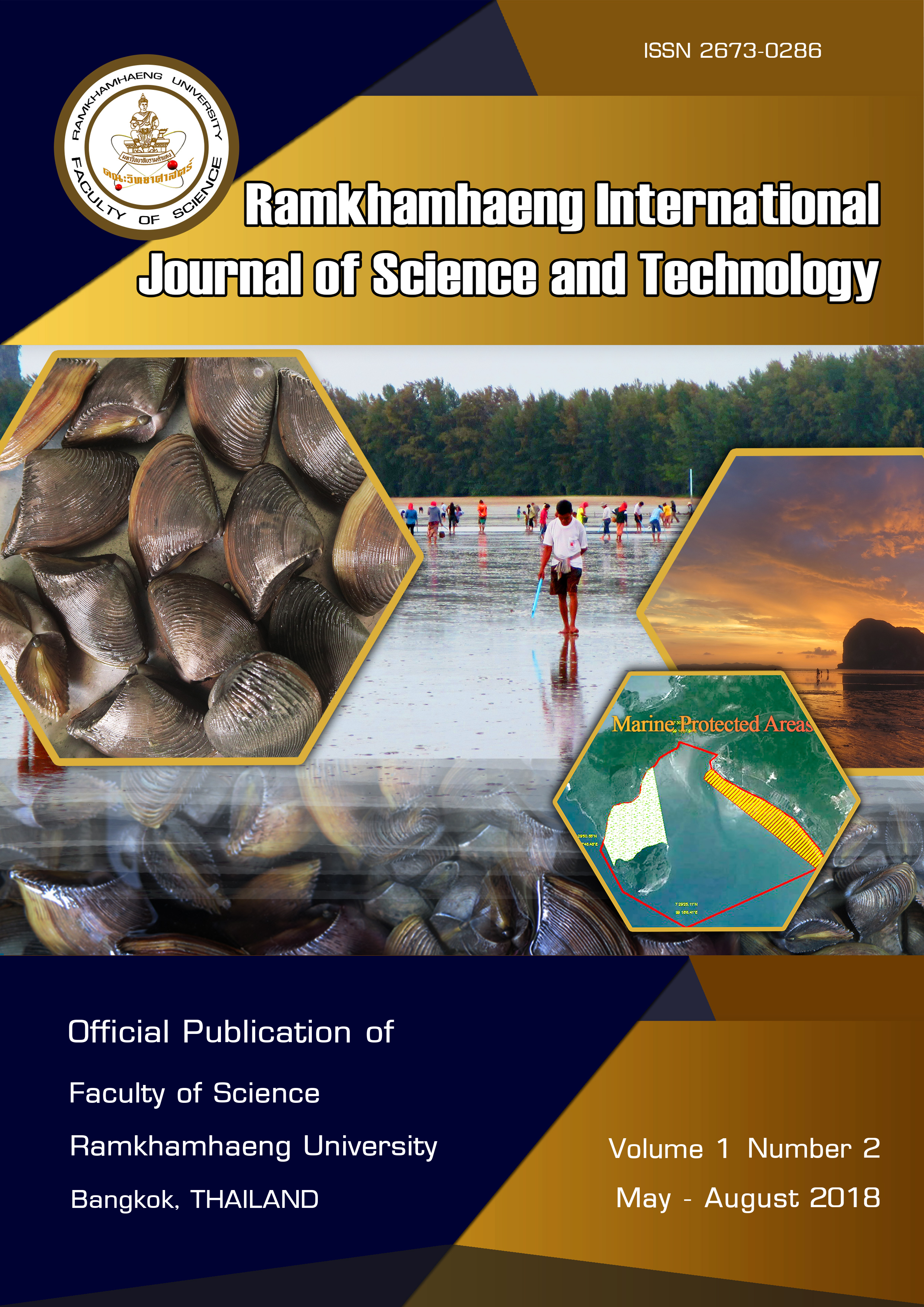Molecular-taxonomic investigation of the wedge clam Donax scortum (Linnaeus, 1758) from the Andaman Sea Coast of Thailand
Keywords:
Donax scortum, molecular genetics, phylogenetic tree, DNA barcoding, Andaman SeaAbstract
The wedge clam Donax scortum (Linnaeus, 1758) is an economically important bivalve in Trang Province and its vicinity in the Andaman Sea. Based on morphological taxonomy, the dominant wedge clam along the Andaman Sea coast of Thailand was identified as D. scortum. The aim of this study was to develop specific COI primers for D. scortum as a molecular approach for reliable taxonomic identification. The wedge clam samples were collected from four localities within fishing grounds, including Hat Chao Mai and Hat Pakmeng in Trang Province, Hat Thung Talay in Krabi Province and Bo Jed Luk in Satun Province. DNA barcoding testing was conducted by sequencing the partial mitochondrial cytochrome c oxidase subunit I (COI) gene. Phylogenetic studies showed that specimens of D. scortum from all study sites were same species in the phylogenetic tree. However, possible cryptic species should be investigated by further studies using morphological and molecular genetic data to clarify their evolutionary history. The COI gene-based investigation may not be sufficient for identification of this clam species. Future investigation on complete mitochondrial genomes may show a different explanation for the evolutionary history of D. scortum. This study provides important data for phylogenetic study of D. scortum.
References
Ansell AD (1983) The biology of the genus Donax. In McLachlan A. and Erasmus T. (eds) Sandy beaches as ecosystems. The Hague: Dr. W. Junk Publishers, pp. 607–635
Endo K, Noguchi Y, Ueshima R, Jacobs TH (2005) Novel repetitive structures, deviant
protein-encoding sequences and unidentified ORFs in the mitochondrial genome of the
brachiopod Lingula anatina. Mol Evol 61:36e53
Guarniero I, Plazzi F, Bonfitto A, Rinaldi A, Trentini M, Passamonti M (2010) The bivalve mollusc Mactra corallina: genetic evidence of existing sibling species. J Mar Biol Assoc UK 90(3):633–644
Huang X, Madan A (1999) CAP3: A DNA sequence assembly program. Genome Res 9(9):868–877
Hebert PDN, Cywinska AA, Ball SL, deWaard JR (2003) Biological identifications through
DNA barcodes. P Roy Soc Lond B Bio 270:313–321
Jitpukdee S, Tantikamton K, Thanee N, Tantipanatip W (2015) Species diversity of benthic macrofauna on the intertidal zone of seacoasts in Krabi, Trang and Satun Provinces, Thailand. IJAT 11(8):1767–1780
Kim SG, Karagozlu MZ, Kim CB (2017) Phylogenetic investigations of Lingula anatina among some northwestern Pacific populations, based on mitochondrial DNA cytochrome c oxidase subunit I gene. J Asia-Pac biodivers 10(2):162–166
Klinthong W, Yeemin T, Sutthacheep M, Wongsuryrat M, Prickchoopon T, Aunkhongthong W, Niyomthai P (2017) Population structure of wedge clam on sandy beaches in Trang Province. Proceedings of the 43rd Congress on Science and Technology of Thailand (STT 43) 2017:300–303
Kumar S, Stecher G, Tamura K (2016) MEGA7: molecular evolutionary genetics analysis version 7.0 for bigger datasets. Mol Biol Evol 33(7):1870–1874
Luo YJ, Satoh N, Endo K. 2015. Mitochondrial gene order variation in the brachiopod Lingula anatina and its implications for mitochondrial evolution in lophotrochozoans. Mar. Genom 1:31e40
Mikkelsen NT, Schander C, Willassen E (2007) Local scale DNA barcoding of bivalves (Mollusca): a case study. Zoologica Scripta 36(5):455–463
Nantón A, Freire R, Arias-Pérez A, Gaspar MB, Méndez J (2015) Identification of four Donax species by PCR–RFLP analysis of cytochrome c oxidase subunit I (COI). Eur Food Res Technol 240(6):1129–1133
Pengsakun S, Yeemin T, Sutthacheep M, Wongsuryrat M, Printrakoon C, Prickchoopon T, Aunkhongthong W (2017) Temporal and spatial distribution of Donax scortum (Bivalvia: Donacidae) from Hat Chao Mai National Park. Proceedings of the 43rd Congress on Science and Technology of Thailand (STT 43) 2017:278–283
Radulovici A, Archambault P, Dufresne F (2010) DNA barcodes for marine biodiversity:
moving fast forward. Diversity 2:450–472
Rongprakhon S, Yeemin T, Sutthacheep M, Chamchoy C, Aunkhongthong W, Niyomthai P, Mue-suea O (2018) Abundance of the wedge clam, Donax scortum from small scale fisheries in Krabi, Trang and Satun Provinces. Proceedings of the 44th Congress on Science and Technology of Thailand (STT 44) pp. 326–331
Singh YT (2017) Status of population dynamics of the Asian wedge clam, Donax scortum (Bivalvia: Donacidae): a first report from Asia. J Mar Biol Assoc UK 97(8):1635–1642
Singh YT, Krishnamoorthy M, Thippeswamy S (2012) Seasonal changes in the biochemical composition of wedge clam, Donax scortum from the Padukere beach, Karnataka. Recent Res Sci Technol 4(12)
Supmee V, Ngernsiri L, Sriboonlert A, Wonnapinij P, Sangthong P (2012) Population genetic analysis of violet vinegar crab (Episesarma versicolor) along the Andaman Sea coast of Thailand. Zool Stud 51(7):1040–1050
Tanyaros S (2010) Sand elimination by Donax scortum (Dance, 1982) (Bivalvia: Donacidae). Molluscan Res 30:138–142
Thompson JD, Higgins DG, Gibson TJ (1994) CLUSTAL W: improving the sensitivity of progressive multiple sequence alignment through sequence weighting, position-specific gap penalties and weight matrix choice. Nucleic Acids Res 22(22):4673–4680
Wallace DC, Chalkia D (2013) Mitochondrial DNA genetics and the heteroplasmy
conundrum in evolution and disease. Cold Spring Harb Perspect Biol 5:a021220. http://dx.doi.org/10.1101/cshperspect.a021220
Weigelt R, Lippert H, Borges LM, Appelqvist C, Karsten U, Bastrop R (2016) First time DNA barcoding of the common shipworm Teredo navalis Linnaeus 1758 (Mollusca: Bivalvia: Teredinidae): Molecular-taxonomic investigation and identification of a widespread wood-borer. J Exp Mar Biol Ecol 475:154–162
Yang S, Lai X, Sheng G, Wang S (2013) Deep genetic divergence within a “living fossil” brachiopod Lingula anatina. J Paleontol 87:902e908
Downloads
Published
Issue
Section
License
Copyright Notice: a copyright on any article in the published journal is retained by the Ramkhamhaeng International Journal of Science and Technology. Readers or Users grant the right to use of the Article contained in the Content in accordance with the Creative Commons CC BY-NC-ND license and the Data contained in the Content in accordance with the Creative Commons CC BY-NC-ND.



